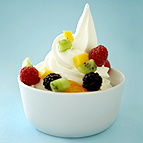The Skinny on... Yogurt
From fat-free and flavored to kefir, here’s how to buy, store and cook with this healthy, versatile favorite from the dairy case.
Cooking with yogurt
Baking is the easiest way to use yogurt.
Substitute plain yogurt for half the liquid
(like milk or juice) in recipes for cakes,
waffles, pancakes or muffins. In general,
yogurt works best in cakey baked goods;
it requires more complex chemistry if
substituted in cookies and crusts.
Yogurt is a fine substitute for sour cream
on baked potatoes, in creamy soups,
salad dressings and as the base for dips.
Or use yogurt instead of cream or coconut milk to enrich a sauce, soup or
stew. It may make the sauce more tart than intended, so seasonings may
need to be adjusted.
One warning: Yogurt will “break” over the heat (that is, break down into a
watery liquid and thick threads). To avoid this, make sure the yogurt is at
room temperature, do not let it boil over the heat, and stir 1 teaspoon
cornstarch into it before using. Goat and sheep yogurt tend to be the most
stable in cooking.
 |
Can frozen yogurt make any health
claims?
Yes — but only if the label specifically says that the
frozen yogurt contains active bacterial cultures. Heat
kills the bacteria — and some frozen yogurts are made
by heating the mixture before freezing it, thus killing off
the good stuff in yogurt. |
| Kinds of Yogurt |
| Fat-free: Means it’s made from fat-free milk. It is, however, not strictly fat-free.
The USDA allows manufacturers to label any product with less that 0.5 percent
milk fat as “fat-free.” Read the label to know what you’re getting. |
| Low-fat: Usually made from 0.5 or 2 percent milk. It’s sometimes labeled “lite” or
“light.” |
| Whole-milk: Made from whole milk with at least 3.25 percent milk fat. |
| Flavored: Yogurt to which any number of flavorings have been added, from
strawberry to maple. In 1933, fruit jam was added to yogurt to preserve its shelflife
— and first sold by Dannon in the U.S. In general, to keep the fruit tasting
bright, flavored yogurts have a high sugar content. To avoid this, look for sugarfree
flavored yogurts. |
| Jameed: A salted and dried yogurt, popular in Middle Eastern cooking. |
| Kefir: One of many yogurt drinks, this one’s made with yogurt and yeast, often
mixed with fruits or fruit juices. |
| Swiss yogurt, German yogurt or Rahmjogurt: Made from part cream and thus
with a much higher fat content, up to 10 percent. (“Rahm” is German for cream.) |
| Soy: Made with soy milk and the same cultures used in other yogurts. |
| Skyr: Fat-free yogurt from Iceland that’s made with the two traditional bacteria as
well as rennet, a familiar enzyme from cheese-making. The result is a very thick,
creamy, fat-free yogurt. |
| Yogurt PointsPlus™ Values at a Glance |
| Fat-free plain yogurt: 1/2 cup = 1 PointsPlus value |
| Fat-free fruit-flavored yogurt: 1/2 cup = 3 PointsPlus values |
| Low-fat plain yogurt: 1/2 cup = 2 PointsPlus values |
| Low-fat fruit-flavored yogurt: 1/2 cup = 3 PointsPlus values |
| Whole-milk yogurt: 1/2 cup = 2 PointsPlus values |
| Plain soy yogurt: 1/2 cup = 2 PointsPlus values |
| Fat-free frozen yogurt: 1/2 cup = 3 PointsPlus values |
| Low-fat frozen yogurt: 1/2 cup = 3 PointsPlus values |